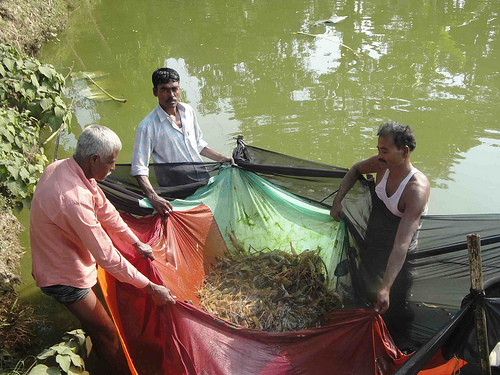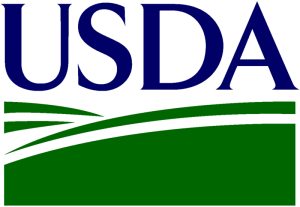Food for Progress Project in Bangladesh Helps Develop Prawn Farming
Food for Progress Project in Bangladesh Helps Develop Prawn Farming
 Market linkage has been established for selling the prawn produced in the area, which has resolved the marketing problem initially faced by the farmers. (Photo credit to Winrock International)
Market linkage has been established for selling the prawn produced in the area, which has resolved the marketing problem initially faced by the farmers. (Photo credit to Winrock International)
A recent Food for Progress (FFP) project in Bangladesh shows how a small effort can have a big impact on a community. The Rural Enterprise for Alleviating Poverty project is managed by Winrock International with the help of USDA and the Ministry of Fisheries in Bangladesh. The goal of this project was to help local farmers boost their incomes by adding prawns and vegetables into their existing farming efforts.
Freshwater prawn, locally called Golda, is a high-value aquaculture crop that is in great demand both in Bangladesh and internationally. Winrock provided training to local farmers on how to develop juvenile prawns in local ponds. Sixty prawn farmers developed and operated nurseries in a pilot program, producing more than 450,000 juvenile prawns. Those prawns were then sold to other interested farmers to expand their efforts, resulting in marketable size prawns.
During the two-year project, Azizul Haque became one of the most successful prawn nursery operators. After receiving training, he started his own business and harvested 18,980 juvenile prawns in his first two months, resulting in a $1,288 profit. “I have got another avenue to earn my livelihood with more income,” said Haque. “Now I am promoted from hawker to prawn producer.”
Haque is just one of the thousands of farmers who have adopted prawn farming and increased their earning potential. These farmers can now better provide for their families and make a positive contribution to the community by expanding their businesses and creating job opportunities for their neighbors.

Abdus Sattar (on the right) has cultured freshwater prawn in his pond under the guidance of the Rural Enterprise for Alleviating Poverty project. He said, “I am now confident to grow prawn in my ponds and earn additional income along with other fishes in same pond.” Sattar is harvesting marketable prawn from his pond. Photo credit to Winrock International.
Through Food for Progress, USDA’s Foreign Agricultural Service (FAS) provides for the donation or credit sale of U.S. commodities to developing countries and emerging democracies committed to introducing and expanding free enterprise in the agricultural sector. Commodities are monetized to support agricultural projects that increase rural incomes and enhance food security by improving agricultural productivity, supporting agribusiness development, and expanding availability of financial services.
The Rural Enterprise for Alleviating Poverty project began in March 2009 with a budget of $730,000 and was completed in September 2011. Over the course of two years, the project was able to track more than $1 million of additional farmer income generated as a result of the training.
By Katie Gorscak
Foreign Agricultural Service
###
About United States Department of Agriculture (USDA)
Mission Statement
The United States Department of Agriculture (USDA) provides leadership on food, agriculture, natural resources, and related issues based on sound public policy, the best available science, and efficient management.
Vision
The USDA want to be recognized as a dynamic organization that is able to efficiently provide the integrated program delivery needed to lead a rapidly evolving food and agriculture system.
Strategic Plan Framework
USDA has created a strategic plan to implement its vision. The framework of this plan depends on these key activities: expanding markets for agricultural products and support international economic development, further developing alternative markets for agricultural products and activities, providing financing needed to help expand job opportunities and improve housing, utilities and infrastructure in rural America, enhancing food safety by taking steps to reduce the prevalence of foodborne hazards from farm to table, improving nutrition and health by providing food assistance and nutrition education and promotion, and managing and protecting America’s public and private lands working cooperatively with other levels of government and the private sector.
USDA Celebrates 150 Years
In 2012, USDA will commemorate and celebrate the 150th anniversary of our founding in 1862, when President Abraham Lincoln signed into law an act of Congress establishing the United States Department of Agriculture.
Two and one-half years later, in what would be his final annual message to the Congress, Lincoln called USDA “The People’s Department.” At that time, about half of all Americans lived on farms, compared with about 2 percent today. But through our work on food, agriculture, economic development, science, natural resource conservation and a host of issues, USDA still fulfills Lincoln’s vision – touching the lives of every American, every day.
“As we commemorate 150 years of accomplishments, USDA is learning from past experiences and looking to the future. In the years to come, we must help address the changing needs of agriculture and rural America. We must continue to help provide a safe, ample food supply for our nation and the world. To meet those goals, we are working to make USDA a more modern and effective service provider and to deliver the best possible results for all of the American people.”
###
* The above story is adapted from materials provided by United States Department of Agriculture (USDA)
![]() ______________________________________________________________________
______________________________________________________________________



















